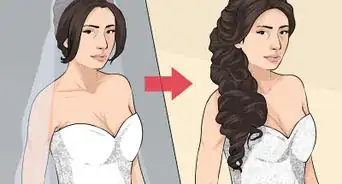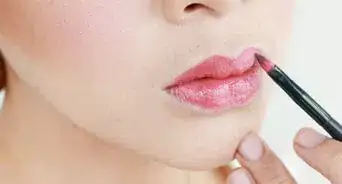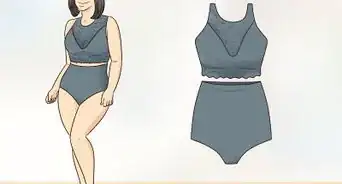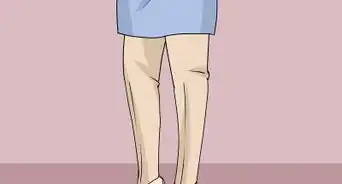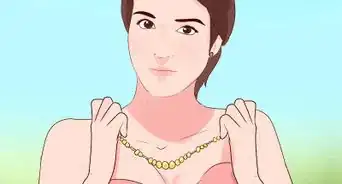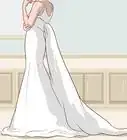wikiHow is a “wiki,” similar to Wikipedia, which means that many of our articles are co-written by multiple authors. To create this article, 19 people, some anonymous, worked to edit and improve it over time.
This article has been viewed 330,066 times.
Learn more...
After your wedding gown, a veil is one of the most defining aspects of your bridal appearance. Historically a veil was worn to protect the bride from evil spirits; nowadays it is simply considered a beautiful form of adornment. Today’s bride can choose any type of veil she desires, but it is important to understand that a veil is an accessory, and as such only one part of your overall look. You need to consider how it will work with your dress, face shape, body shape, hairstyle and wedding location. Read below the jump for helpful information on choosing the perfect veil for your wedding.
Steps
-
1Consider your dress. One of the most important considerations is selecting a veil that complements your dress.[1]
-
2Assess where the key focal points occur on your dress. For example, do you have an embellished bust panel, or perhaps a back detail you’d like to show off? In this case you need to either select a veil that ends before your point of detail, or choose a longer, sheer style that you can see the detailing through.Advertisement
-
3Consider the style and the level of decoration on your gown. In general, if you have quite a simple dress you can carry off a more elaborate veil. However if your dress is very detailed, a simple veil often looks more flattering. Only the most formal of weddings, such as royal weddings, tend to accommodate the combination of both an elaborate dress and veil.
- Wedding gowns fall under several different broad styles and your veil needs to work with this style. There’s the classic style, which is formal, symmetrical and usually elaborate in some way. The romantic style possesses an element of softness and usually incorporates lots of attention to detail. The sophisticated style is an understated look that is free from fussy details and the eclectic look is creative with unexpected touches. All of these factors need to be considered when you choose your veil; length, width, color, tiers, and decoration.
-
4Consider the different lengths.[2]
- Very short veils such as visor veils do not extend past the chin. Visor veils resemble fascinators worn to horse-racing events. If your bridal gown has a high neck detail, this type of veil can work well. They are a good style to pair with sophisticated or eclectic style wedding gowns.
- Shoulder length veils are around 20 inches (50.8 cm) in length. They are perfectly suited to dresses that have bust,waist, or lower back details. However, they are often too informal for classic, formal dresses.
- Elbow length veils are approximately 25 inches (63.5 cm) long, this veil falls to around the elbow. They can work well with romantic ball gown style dresses, because they end where the fullness in the skirt begins.
- Waist length veils are just slightly longer than an elbow length veil at approximately 30 inches (76.2 cm). They suit most dress styles that do not feature a train.
- Fingertip length veils are one of the most popular lengths, when you stretch your arm out it reaches around your fingertips. They are approximately 36 inches (91.4 cm) long and also suit the majority of dress styles.
- Knee length veils are approximately 45 inches (114.3 cm) and reach to around your knees. They look good with mid calf length wedding dresses.
- Floor length veils are often referred to as a ballet length veil, they just brush the floor at around 72 inches (182.9 cm). They are well suited to full length gowns that do not have a train.
- Chapel length veils are slightly shorter then cathedral length; these veils still drape onto the floor. They are typically around 90 inches (228.6 cm) long. They are best partnered with dresses that feature a train.
- Cathedral length veils are the longest and therefore most formal, these veils are usually around 120 inches (304.8 cm) long and some extend up to nine feet along the ground. They work best with full length, classic wedding gowns.
-
5Consider the width. Veils typically come in three different widths that create varying degrees of fullness at the sides and top.
- 54 inch (137.2 cm) width is the sleekest version, with limited fullness at the top and sides. If you want to show off a dress detail that is covered by your veil, this type is sheer enough to accommodate. This style hangs behind your shoulders, which means it is ideally paired with dresses that feature decorative straps or sleeves.
- 72 inch (182.9 cm) width is moderate in height and width. It offers some coverage around the arms, so it is a good match for simple shoestring strap dresses. It tends to have a more romantic feel than the 54 inch (137.2 cm).
- 108 inch (274.3 cm) width is the widest and has the most fullness on top. It comes around to cover the arms. This style is great if you are wearing a strapless dress and would like some coverage around your arms and shoulders. However, it is likely to look too overdone with a sophisticated wedding dress.
-
6Think about the color. Your veil needs to be a suitable color match to your wedding gown. There are several white and ivory shades, pinks, beiges and golds. You can also choose between a regular and a shimmer finish. Shimmer veiling offers a distinct shine, which is especially evident under lighting. In contrast regular veiling is matte in appearance. If you want to ensure an exact match, make sure you can order veil swatches to match to your dress.[3]
-
7Figure out how many tiers. You can choose between a one, two and three tier veil. The choice is largely dependent on the style of your dress.
- A one tier veil is suited to a sophisticated look, but a romantic dress often benefits from a two or three tier veil. Classic dresses also tend to require at least two tiers. Multiple tier veils suit simple hairstyles because your hairstyle will not be clear to view under the layers.
- One of the tiers is typically a blusher. This is the part of the veil that is used to cover the brides face during the start of the ceremony.
- Today’s bride is free to choose whether she wants a veil that covers her face or not. It’s a purely personal decision; many brides find the idea of their partner lifting their veil for the first kiss very romantic.
- If you want to wear a blusher you need to select a tiered veil that allows you to flip the blusher point over your face, or the back of your head before your first kiss. It is also best to select a veil that reaches at least shoulder length, because a blusher measures around 30 inches (76.2 cm) in length. A veil that is shorter in the back could look strange. Make sure that your blusher is no longer than 30 inches (76.2 cm), because otherwise it might get tangled up in your flowers.
-
8Choose what type of extras if any you looking for. A veil can be finished in a wide variety of ways. You should select a finish that works with the style of your dress. If your dress is quite simple, you might like to choose a more decorative edge. Structured dresses tend to look good with thicker ribbon edges. Soft, romantic dresses tend to work well with a simply cut edge. It is also a nice idea to subtly mimic any of the details in your dress.
-
9Look at what type of face shape you have. A veil frames your face, so your face shape is an important denominator in choosing a veil. Consider the following advice for your face shape:[4]
- Round face - A round face is virtually as wide as it is long and looks full in appearance. When choosing a veil look for a style that will help make your face look longer and slimmer. It is preferable for your veil to reach at least shoulder length and for it to have some volume on the top of the head. Avoid veils with too much fullness at the sides of the face.
- Square face - A square face is typically wide and angular looking. When choosing a veil look for a style that will soften your face and add length. It is preferable for your veil to reach at least shoulder length and for it to have some volume on the top of the head. Circular and cascading styles can help soften the angular nature of your jaw line.
- Oval face - An oval face shape in slightly longer than it is wide, similar in appearance to an egg shape. As this face shape is well balanced, you are free to experiment with different veil styles. However, it is a good idea to avoid going extreme in either volume or width, to help maintain your proportions.
- Rectangle face - A rectangle face is longer than it is wide and tends to appear narrow and angular. When choosing a veil look for a style that has width around the face, but no height at the top of the head.
-
10Find out your body type. Your veil has the ability to help correct the proportions of your body shape.
- If you have a large bust or stomach, you will benefit from wearing a long veil that extends to fingertip length or below. This is because it will help elongate your upper body.
- Pear-shaped women tend to look best in veils that end at shoulder, elbow, or waist level. These lengths draw attention to your smaller points, rather then the width of your hips.
- Full-figured women should ideally stick to one tier, narrow width veils to avoid adding extra volume to the look of the body. Tall women can typically carry off longer veils, but shorter women tend to suit veils that are waist height or above.
-
11Know what kind of hairstyle you will be wearing. Your choice in hairstyle plays a role in determining what sort of veil and headpiece you can pull off.
- A heavy head piece, long veil, or multi-tiered veil all require a supportive up-do hairstyle like a bun.
- A half up/half down hairstyle will work with moderate weights and lengths.
- If you intend to wear your hair all down, then it is probably best to stick to lightweight or shorter designs.
- You also need to consider the placement position on your head. Some hairstyles suit a veil that is attached to the front of your head, but others look good with veil that is attached further towards the back.
- If you have short hair you will need to attach the veil towards the front of your head.
- However, if you have long hair and want to show off an elaborate up-do, you will need to position the veil further back. Wide veils typically need to be worn towards the front of your head and veils that do not have gathers look better worn towards the back of the head. Your veil can be attached with a comb and pins or combined with a tiara, crown or headband. It is a good idea to buy your veil well in advance of your wedding date, so that you can take it along to your hair trial.
-
12Know the location of your wedding. You also need to give some practical consideration to selecting a veil that is suitable for your wedding location.[5]
- A cathedral style veil is the ultimate show stopper if you are having a formal wedding in a large church, with several attendants. However it could be disastrous in another setting.
- If you are getting married in a small chapel, then it is best to stick to chapel length or shorter. This is because you won’t have the room to show off a long trailing veil. Cathedral length veils also require frequent assistance from attendants.
- If you are getting married in an outdoor ceremony, there are extra considerations to be mindful of. You may have sand, wind or dirt to contend with. If you’d like to keep your veil in pristine condition, it is advisable to choose a knee length veil or shorter. However, many brides are happy to live it up for the day and aren’t worried about trailing their veil behind them in the sand at the beach, or along a dirt path in a garden setting.
- Also bear in mind that in windy settings a long veil can be difficult to control. Visor veils can work well in these conditions.
- You might also like to consider the climate. For example; in hot, humid weather it is not going to be pleasant to be swathed in full layers that could stick to your skin.
Community Q&A
-
QuestionMy dress is floral lace, cascades from a sheer lace high neckline, has a mermaid train, open keyhole back, and bare shoulders. I am 5 ft 3 and a size 8 build. What type of veil do you think will work?
 Community AnswerYour dress sounds beautiful. I'd say you should choose a veil coming from the back of your head flowing down to the small of your back in an A line shape, with embroidery on the bottom.
Community AnswerYour dress sounds beautiful. I'd say you should choose a veil coming from the back of your head flowing down to the small of your back in an A line shape, with embroidery on the bottom. -
QuestionI have ruffled ball gown wedding dress, what kind of veil I should wear?
 Community AnswerThere aren't really any rules when it comes to veils; just choose one you like. Your dress is dramatic, so you can either double up on the drama and go long or go shorter and simple to avoid competing with your dress.
Community AnswerThere aren't really any rules when it comes to veils; just choose one you like. Your dress is dramatic, so you can either double up on the drama and go long or go shorter and simple to avoid competing with your dress. -
QuestionMy daughter's dress is all satin and is kind of ball/A-line style with a train. What kind of veil should she wear?
 Community AnswerWear a very long veil with it running down with the train.
Community AnswerWear a very long veil with it running down with the train.
References
- ↑ https://www.glamour.com/gallery/the-dos-and-donts-of-choosing-your-wedding-dress
- ↑ https://www.glamour.com/story/how-to-choose-the-right-weddin
- ↑ https://www.theknot.com/content/wedding-veil-tips-and-trends
- ↑ https://www.theknot.com/content/choose-the-right-wedding-veil-for-your-face
- ↑ https://www.marthastewart.com/7948592/how-choose-your-wedding-dress
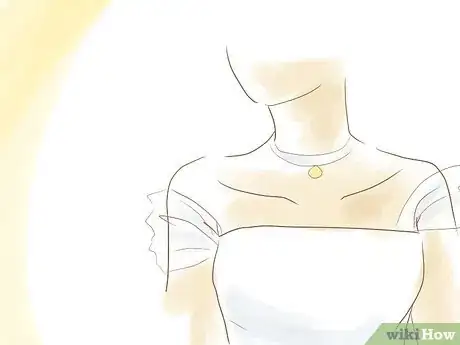
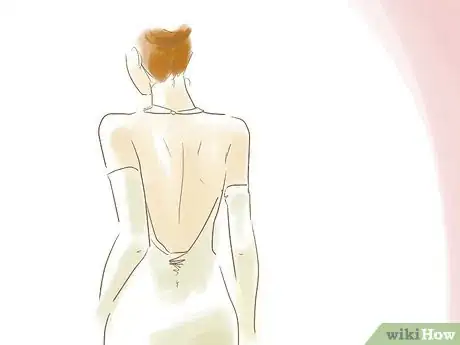
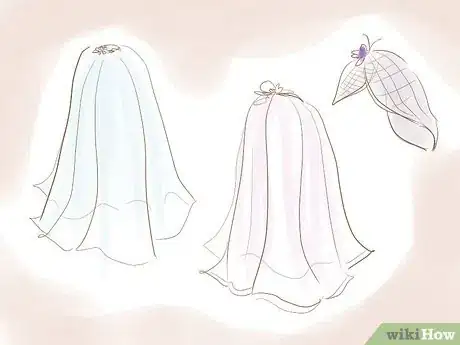
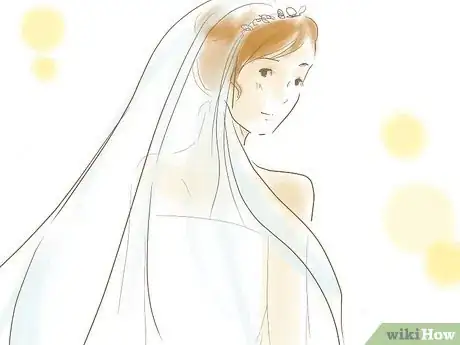
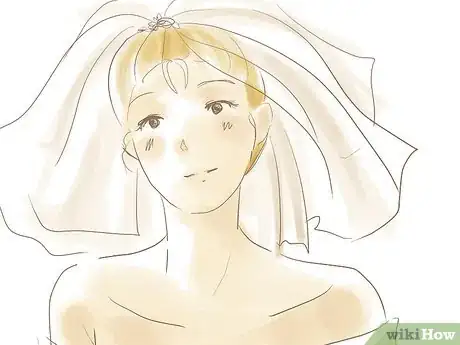
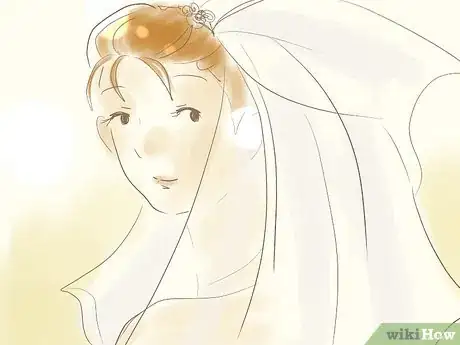

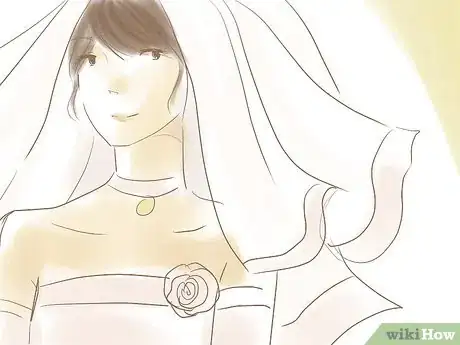

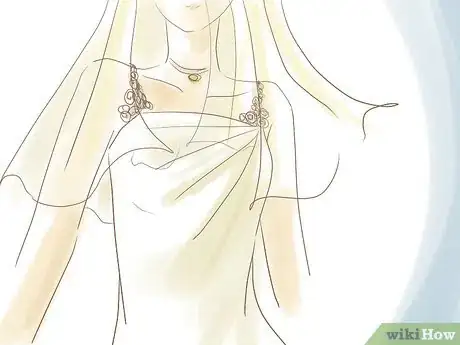
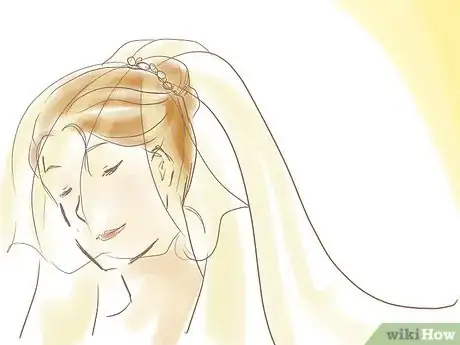
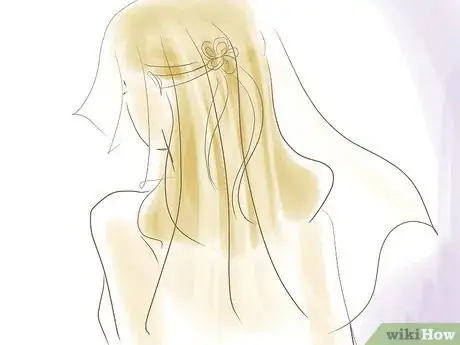
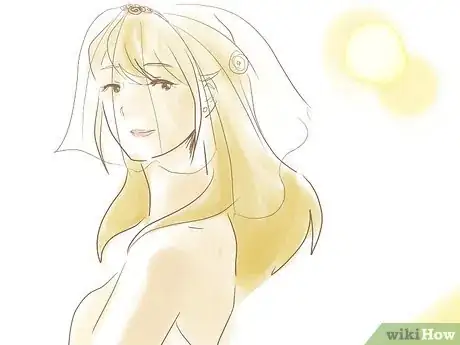



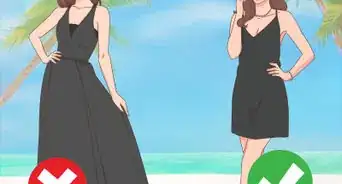

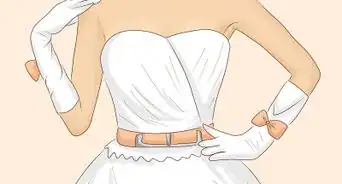
-Step-15-Version-2.webp)


